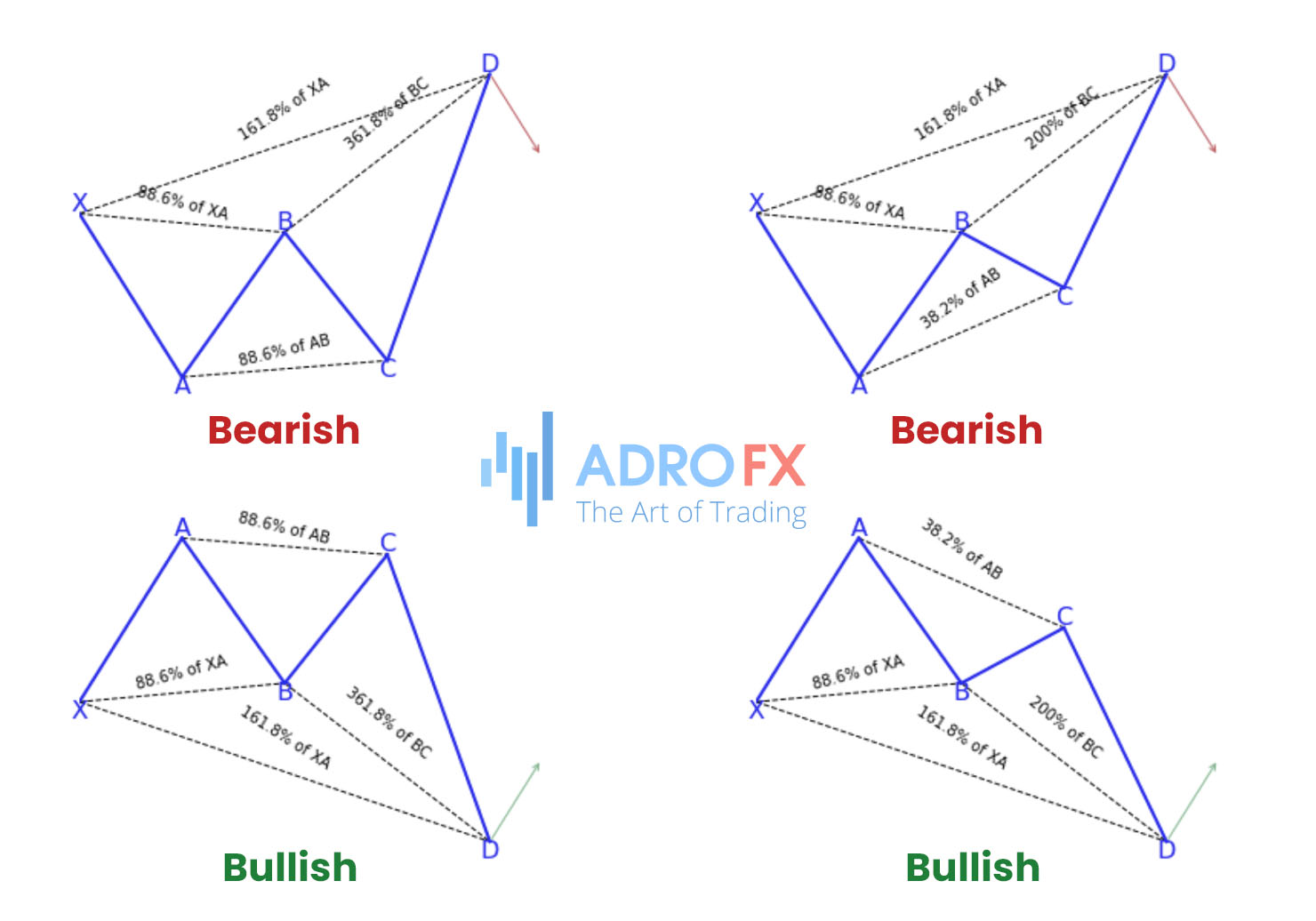High Reward, Low Risk: The Power of the Crab Pattern in Forex

Forex trading patterns are essential tools for traders aiming to predict market movements and make informed decisions. These patterns, formed by price movements on charts, help traders identify potential turning points and market trends. Among the various types of trading patterns, harmonic patterns stand out due to their precision and reliability. Harmonic patterns are based on specific Fibonacci ratios, providing a structured approach to analyzing market behavior.
One of the most intriguing harmonic patterns is the Crab pattern. Understanding the Crab pattern can be particularly beneficial for traders seeking high reward-to-risk opportunities. This pattern's unique structure and precise Fibonacci ratios make it a valuable addition to any trader's toolkit.
What Is the Crab Pattern?
The Crab pattern is a specific type of harmonic pattern used in forex trading to predict potential reversal points. It was introduced by Scott Carney in the early 2000s as part of his work on harmonic trading. The Crab pattern is characterized by its distinct structure, which includes four legs labeled X-A, A-B, B-C, and C-D. Each leg represents a significant price movement, and the pattern's accuracy relies heavily on the precise Fibonacci ratios between these legs.

In detail, the Crab pattern consists of four primary legs. The first leg, X-A, initiates the pattern. This is followed by the A-B leg, which retraces a portion of the X-A leg. The B-C leg then extends beyond the starting point of X-A, but the most critical part of the pattern is the C-D leg, which typically extends to 1.618 times the X-A leg. Each of these legs adheres to specific Fibonacci ratios, which are crucial for the pattern's identification and validation. This meticulous adherence to Fibonacci ratios makes the Crab pattern a reliable tool for traders looking to capitalize on market reversals.
Identifying the Crab Pattern
Recognizing specific patterns can greatly enhance a trader's ability to predict price movements and make informed decisions. One such pattern, known as the Crab pattern, is a harmonic pattern that offers precise entry and exit points based on its structure. Understanding how to identify and trade the Crab pattern can be a valuable skill for traders looking to capitalize on market movements.
Visual Identification
To identify the Crab pattern on forex charts, traders should look for a specific structure comprising four legs: X-A, A-B, B-C, and C-D. The pattern begins with a sharp price movement (X-A), followed by a retracement (A-B). This is succeeded by another price move that extends beyond the starting point (B-C) and culminates in the final leg (C-D), which typically extends significantly. Key characteristics to look for include sharp price movements and precise retracement and extension levels, forming a distinct "M" or "W" shape depending on the trend direction.

Fibonacci Ratios
The Crab pattern relies heavily on Fibonacci ratios to validate its structure. Each leg must adhere to specific ratios for the pattern to be considered valid. The X-A leg is the initial movement that sets the stage for the pattern. The A-B leg retraces 38.2% to 61.8% of the X-A leg. The B-C leg extends 38.2% to 88.6% of the A-B leg. The most critical leg, the C-D leg, typically extends to 1.618 of the X-A leg, confirming the pattern's completion.
Trading the Crab Pattern
Trading the Crab pattern effectively involves precise entry and exit points, along with a solid risk management strategy. By understanding the ideal moments to enter and exit trades and managing potential risks, traders can optimize their use of the Crab pattern in their trading strategies.
Entry Points
The ideal entry point for trading the Crab pattern is typically at the completion of the C-D leg. Traders should confirm the pattern using additional indicators or price action signals before entering a trade. This confirmation helps ensure the validity of the pattern and reduces the risk of false signals.

Stop Loss and Take Profit Levels
Setting appropriate Stop Loss orders is crucial to minimize risk when trading the Crab pattern. These orders should be placed just beyond the pattern's completion point to protect against unexpected price movements. Determining Take Profit levels involves analyzing the pattern's structure and setting targets based on Fibonacci extension levels and previous price action. The chart above illustrates the entry point (D), Stop Loss, and Take Profit levels.
Risk Management
Effective risk management is essential when trading the Crab pattern. Traders should allocate a specific portion of their capital to each trade and avoid over-leveraging. Practical tips for managing risk include using Stop Loss orders, setting realistic profit targets, and maintaining a disciplined approach to trading. By adhering to these principles, traders can enhance their chances of success and protect their investments.
Advantages of Using the Crab Pattern
The Crab pattern is a powerful tool for forex traders due to its unique structure and reliance on specific Fibonacci ratios. Understanding its advantages can help traders leverage its potential for profitable trading.
High Reward-to-Risk Ratio
One of the main advantages of the Crab pattern is its high reward-to-risk ratio. This pattern is designed to provide traders with precise entry and exit points, minimizing risk while maximizing potential returns. The key lies in the pattern's structure, which often results in significant price movements after the completion of the C-D leg. Successful trades using the Crab pattern demonstrate how effective it can be in capturing substantial market moves, allowing traders to achieve impressive returns relative to their initial risk.
Precision and Reliability
The Crab pattern's precision and reliability stem from its strict adherence to Fibonacci ratios. Each leg of the pattern must conform to specific retracement and extension levels, ensuring that the pattern is well-defined and less prone to false signals. This mathematical foundation provides traders with confidence in the pattern's ability to predict market movements accurately. The precise nature of the Fibonacci ratios involved makes the Crab pattern a reliable tool for identifying potential reversal points in the market.

Limitations and Challenges
While the Crab pattern offers significant advantages, traders must also be aware of its limitations and challenges to use it effectively.
Complexity in Identification
One of the primary challenges of the Crab pattern is its complexity in identification. Accurately spotting the pattern requires a keen eye and a deep understanding of its structure. Traders often struggle with distinguishing the Crab pattern from similar harmonic patterns, leading to potential mistakes. Common errors include misidentifying the legs of the pattern or incorrectly applying Fibonacci ratios, which can result in unsuccessful trades.
Market Conditions
The performance of the Crab pattern can vary depending on market conditions. In highly volatile markets, the pattern may not form as expected, leading to false signals. Conversely, in low volatility environments, the pattern may take longer to develop, testing traders' patience. Understanding how different market conditions impact the Crab pattern is crucial for traders to adjust their strategies accordingly.
Tools and Software for Identifying the Crab Pattern
Using the right tools and software can greatly enhance a trader's ability to identify and trade the Crab pattern effectively.
Charting Tools
Charting tools are essential for visualizing the Crab pattern and applying Fibonacci ratios accurately. Recommended charting tools include MetaTrader, TradingView, and NinjaTrader. When choosing a charting tool, traders should look for features such as customizable Fibonacci tools, pattern drawing capabilities, and real-time data feeds. These features enable traders to accurately plot the pattern and make informed trading decisions.
Automated Pattern Recognition Software
Automated pattern recognition software can simplify the process of identifying harmonic patterns, including the Crab pattern. These tools use algorithms to scan the market for potential patterns, saving traders time and reducing the risk of human error. Benefits of using automated software include increased efficiency, the ability to monitor multiple markets simultaneously, and the provision of real-time alerts. Examples of such software include Harmonic Pattern Scanner and ZUP indicator for MetaTrader, which help traders quickly identify and act on potential Crab pattern setups.
Conclusion
The Crab pattern is a powerful harmonic pattern that offers traders high reward-to-risk ratios due to its precise Fibonacci structure. Understanding its components, including the X-A, A-B, B-C, and C-D legs, is crucial for accurate identification and successful trading.
For traders looking to incorporate the Crab pattern into their forex trading strategies, practice and continued learning are essential. Mastering the identification and trading of this pattern can significantly improve trading outcomes, but it requires diligence and attention to detail. As market conditions evolve, staying adaptable and continuously educating oneself about new trading tools and techniques will ensure long-term success in forex trading. Embrace the challenge of learning the Crab pattern, and use it as a valuable addition to your trading arsenal.
About AdroFx
Established in 2018, AdroFx is known for its high technology and its ability to deliver high-quality brokerage services in more than 200 countries around the world. AdroFx makes every effort to keep its customers satisfied and to meet all the trading needs of any trader. With the five types of trading accounts, we have all it takes to fit any traders` needs and styles. The company provides access to 115+ trading instruments, including currencies, metals, stocks, and cryptocurrencies, which make it possible to make the most out of trading on the financial markets. Considering all the above, AdroFx is the perfect variant for anyone who doesn't settle for less than the best.










